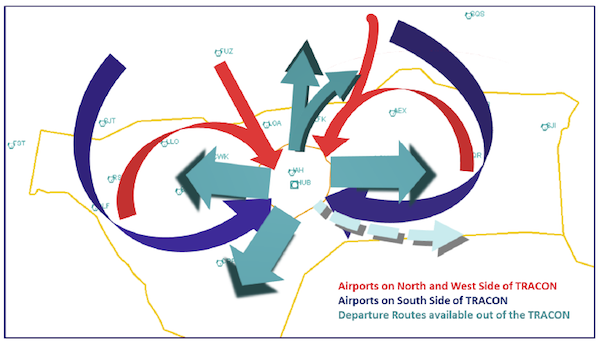
Feb. 3, 2017 // Houston Area Facilities Prepare For A Big Super Bowl of Air Traffic
 |
| In anticipation of a large number of aircraft operating in the Houston, Texas, area during the week of Super Bowl LI, the above general special air traffic procedures will be used to minimize air traffic delays and enhance safety. |
Much like the Atlanta Falcons and the New England Patriots, who are set to meet Sunday at Houston’s NRG Stadium in Super Bowl LI, NATCA members and their Federal Aviation Administration management counterparts at Houston-area facilities have been preparing for months for their own Super Bowl challenge, ready to put their experience, skills, and hard work to the test.
It’s the Super Bowl of ATC, and it has already begun, with the influx of traffic coming into the area for the big weekend and the promise of a grand finale: the departures back home that begin immediately after the game ends late Sunday evening.
It’s Houston’s third Super Bowl, and first since 2004.
“Our brothers and sisters have really been preparing well to handle the huge influx of air traffic,” said Southwest Regional Vice President Andrew LeBovidge, who visited Houston TRACON (I90) last week to see how the plan was unfolding. “They are the epitome of professionalism!”
I90 member Lee Moore, who has helped spearhead the facility’s efforts in planning and preparation, said I90 and Houston Center ZHU members started working together in February 2016. The plan began then “to make sure the estimated 1,300-to-1,600 additional aircraft have safe and efficient procedures to arrive and depart the Houston terminal area,” he said.
The arrival routes for Houston Intercontinental Airport (IAH) and Houston Hobby (HOU) are optimized with Required Area Navigation (RNAV) Standard Terminal Arrival Routes (STARs), but the satellite airports “needed some work,” Moore said.
“The challenge with the satellite airports was that one controller works the arrivals and departures for numerous airports, so creating an airport acceptance rate to each airport within a sector was not realistic,” Moore said. “Instead we needed to figure out what the sector limits would be and how to transfer that data into the non-FA-run slot program.”
I90 and ZHU collaborated on changing arrival routes to maximize capacity and efficiency for the satellite sectors while maintaining a safe operation, Moore said. I90 created a new sector for Super Bowl week that is designed to be a feeder position from ZHU to create an initial sequence to satellite airports.
On the departure side, routes were changed so they would not cross each other within I90’s airspace, which Moore says, “creates a safer and more efficient way to get out of town after the game.”
“There were a lot of people involved with this process, from the Command Center to the local FBOs (fixed base operators), and everyone collaborated to create the best product we possibly could,” he added.

